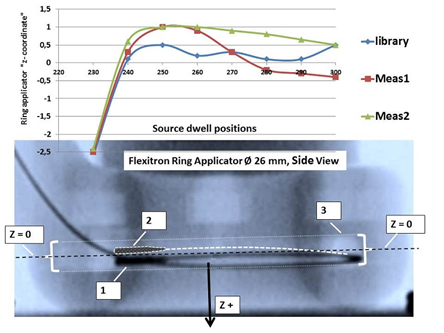Dwell positions of the source in Ring Applicator (“z-coordinate”) in HDR brachytherapy commissioning
Vladimir Stserbakov,
Estonia
PO-1805
Abstract
Dwell positions of the source in Ring Applicator (“z-coordinate”) in HDR brachytherapy commissioning
Authors: Vladimir Stserbakov1, Andrei Tsizik1, Nikolai Saveljev1
1North-Estonia Medical Center Foundation, Radiotherapy, Tallinn, Estonia
Show Affiliations
Hide Affiliations
Purpose or Objective
For creating adapted to clinical user applicator library (Oncentra Brachy 4.6 treatment planning system,
Flexitron afterloading machine) to collect data about
behaviour/traveling position of the Ir-192 radiation source inside source guiding
channel of most questionable Ring Applicator Ø 26 mm.
Material and Methods
Technique of autoradiography, when X-ray film have been used to visualize
actual position of the radiation source inside the applicator source travel path,
in direction parallel to tandem (“z-coordinate”, Fig., Z+), in this case do not
applicable for technical reason. Thus for the solving this problem the manipulation/handling
with dummy source inside source travel cavity/path is one approach to get
information about source position traveling through. For this purpose the dummy
source cable was installed into extended/modified Source Position Simulator Set
instead of dummy/check cable. Step size of the dummy moving was 1 cm. The
fluoroscopic images of the source inside applicator channel in different dwell
positons was analysed using standard measuring tools. For the point of origin/beginning
of “z-coordinate” was taken the centre of source travel channel Ø 3 mm (Fig., Z=0, 3) and the positive direction of “z-coordinate” it was
taken direction of the applicator tandem. Special care was undertaken (using
angle indicators) to adjust angle of the fluoroscopic image direction view to
be parallel to plate of ring applicator fixation.

Figure. Flexitron Ring Applicator Ø 26 mm, Side View, „Z-coordinate“of dummy
source dwell positions. 1,2 – “300 mm” dwell position of the dummy source for
Measurement type 1 and type 2, respectively.
3 - Source travel path cavity, diameter 3 mm.
Results
On the figure the curves 1 and 2 correspond to two types/groups of
obtained measurements: 1- moving of dummy source into last distal position “300
mm” with Z= ~+0,5 mm; 2 - dummy source, spontaneously,
moving into last distal position “300 mm” with Z= ~-0,4 mm; For start dwell positions
inside ring (“240-260” positions) these curves almost coincide between each
other, but for distal dwell positions (“270-300”) they, unexpectedly, differs by
~1mm. Z-coordinate for library applicator in dwell position “300” close to
Measurement 1 result and in dwell position “270” close to Measurement 2. For
dwell positions “240-260” library Z-coordinate differ from our measurement by
~0,5 mm.
Conclusion
For all dwell positions inside Ring Applicator Ø 26 mm library
“z-coordinates” don’t differ from our measurement more than 1 mm (i.e. gives
contribution ≤5% difference in dose at 4 cm distance), which can be evaluated/valued as small rate. So, for
creating adapted to clinical user Ring Aapplicator library the “z-coordinates” of
source dwell positions, at the first stage, can be copied from library data.